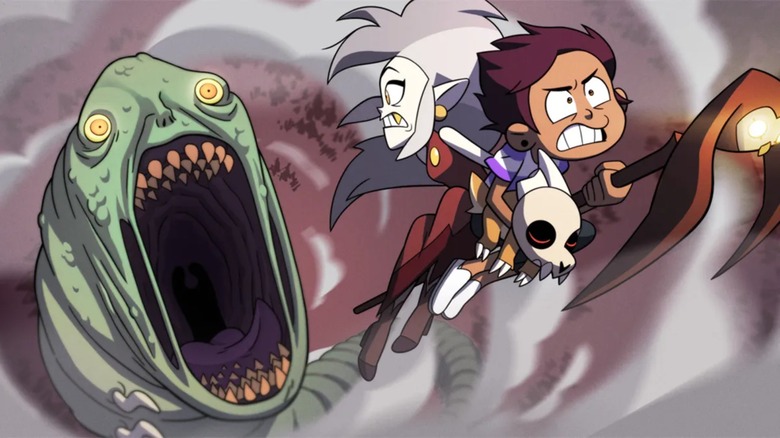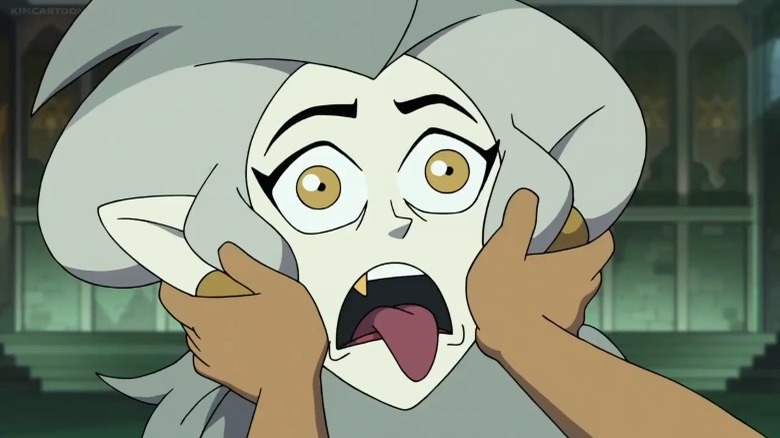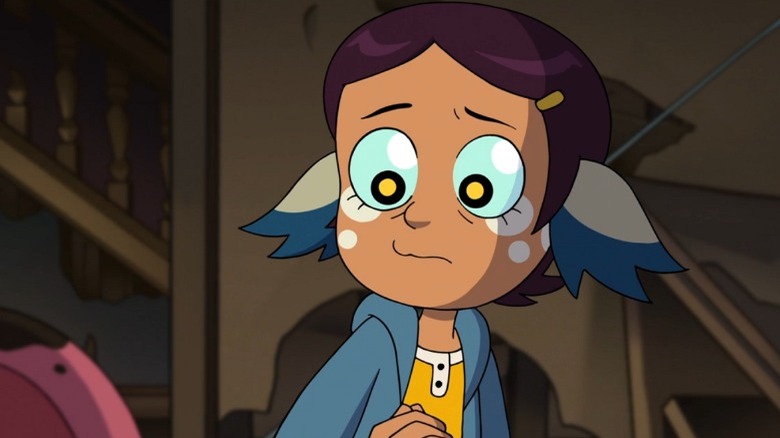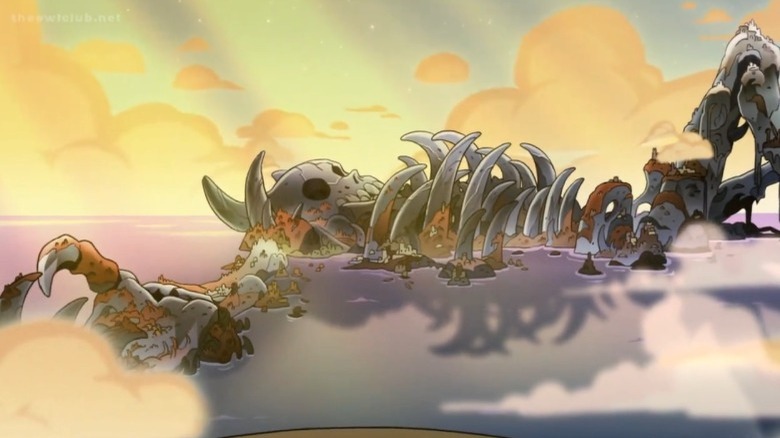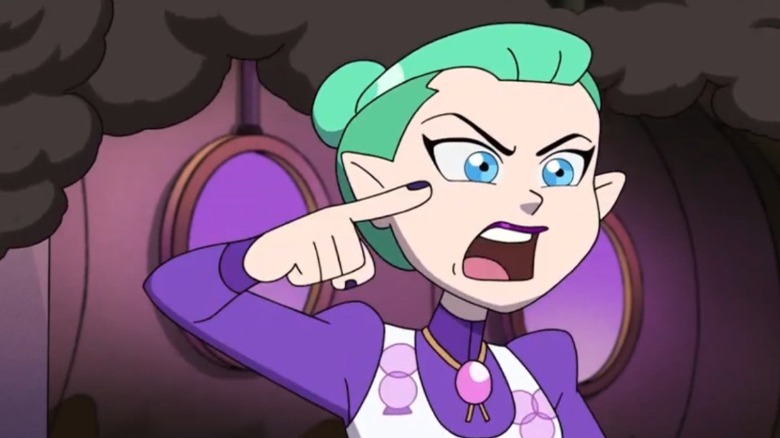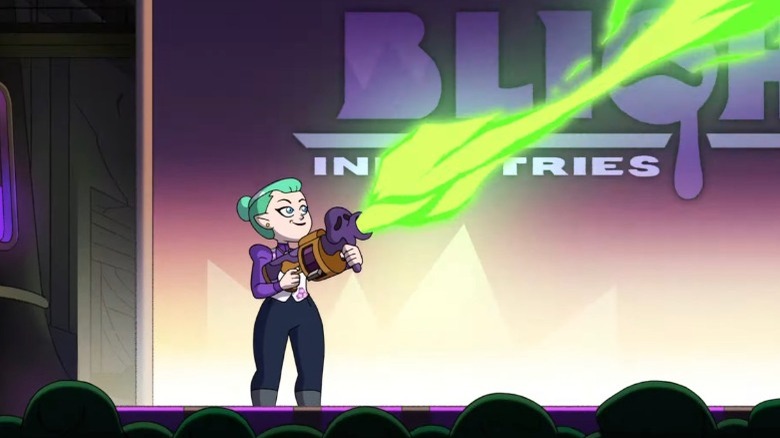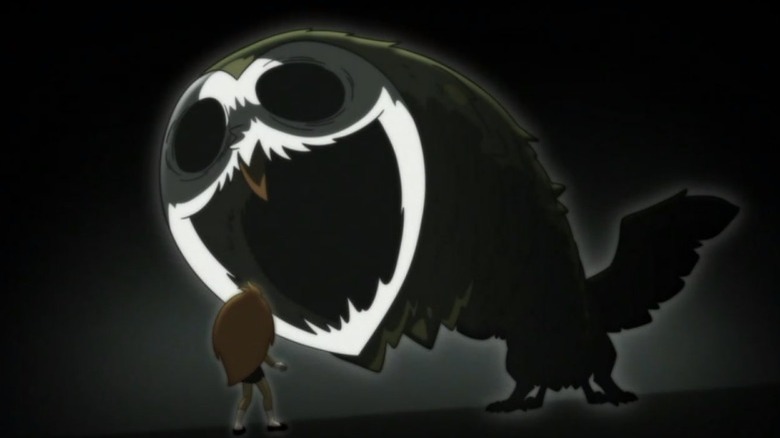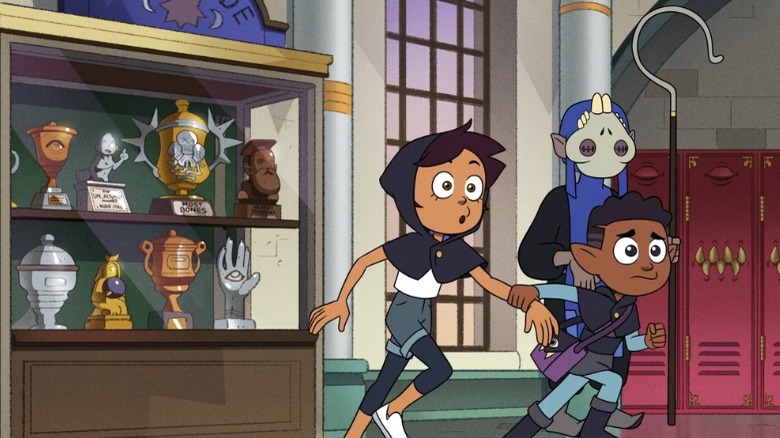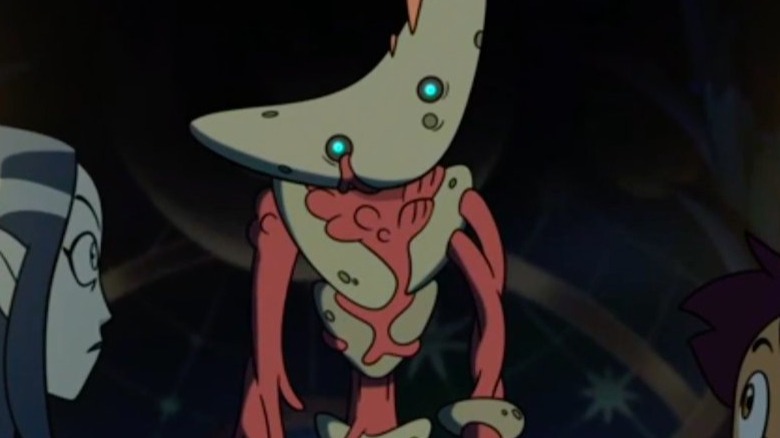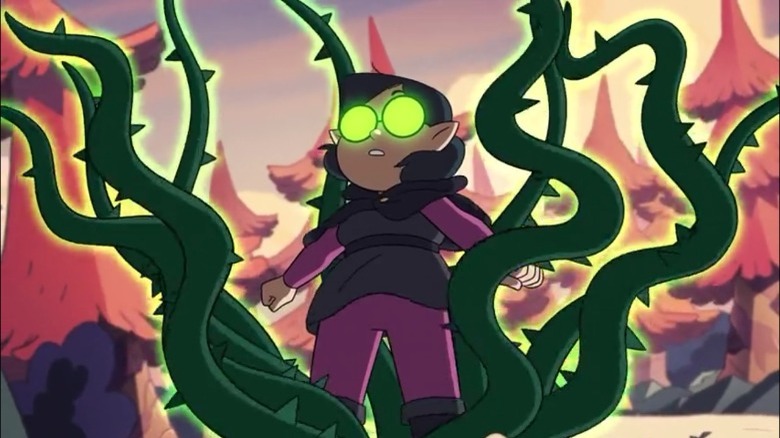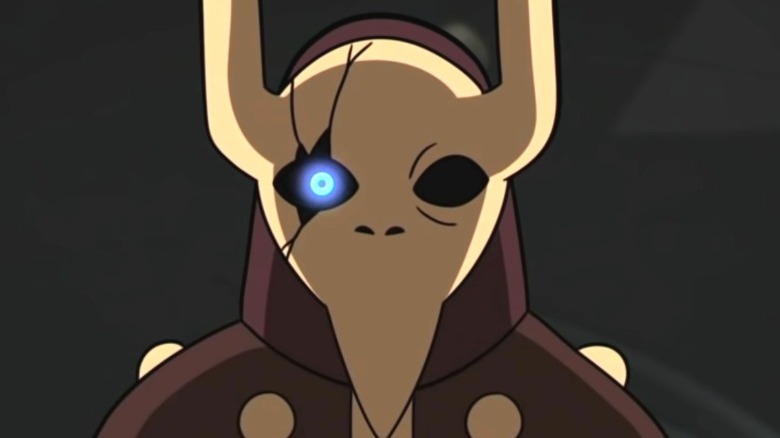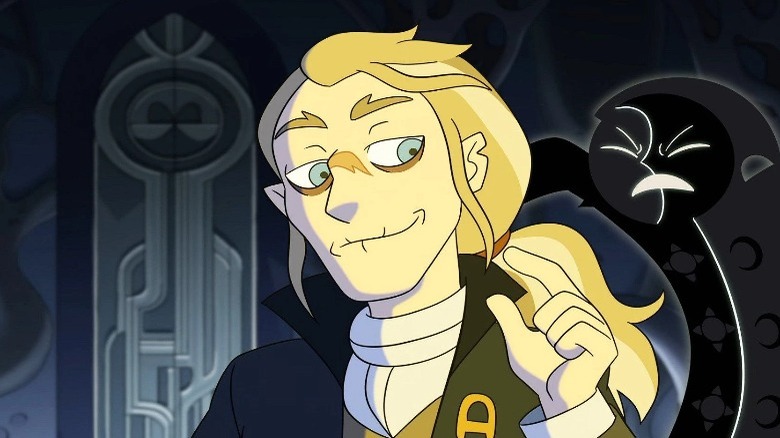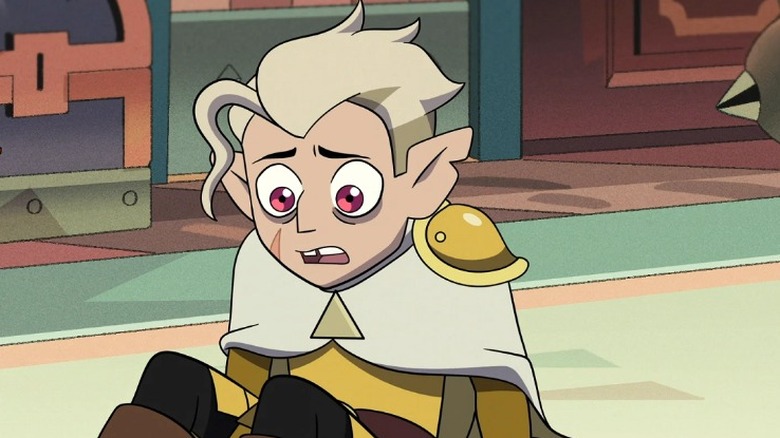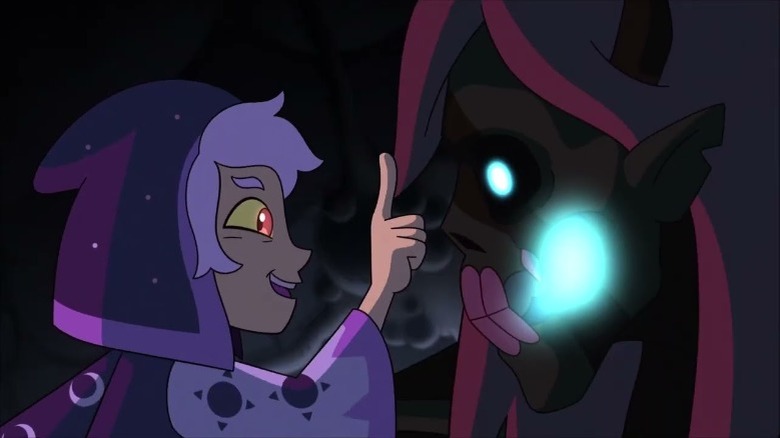The Most Disturbing Moments From Disney's The Owl House
Streaming services like HBO Max are under fire for mistreating animation studios and creators, but Disney's been a quiet canary in that coal mine. "The Owl House" is a spectacular series about a world of wild magic, and it's never afraid to deal with tough topics like betrayal and emotional abuse. Its story treats its diverse and LGTBQ+ cast with refreshing acceptance. Unfortunately, it's also slated to end with a third season consisting of only three 40-minute episodes. This doesn't stop Disney from trotting out the series for promotion during Pride Month. Creator Dana Terrace is quick to point out the cancellation is likely due to the show's darkness and plot complexity, not any bigotry on the Mouse's part.
That rings hollow for fans desperate for more Eda and Luz, and if you're not a fan yet, you should be. It's a terrific show for anyone, and dark enough to delight older kids. To "celebrate" Disney's treatment of the show, here's a rundown of the most disturbing scenes in "The Owl House" so far.
Eda's Creepy Body Control
Luz's arrival on the Boiling Isles is anything but comforting. At least she finds safety in the first episode, crossing paths with the eccentric wild witch Eda Clawthorne, a happy renegade with a demon puppy named King. It's for him that Eda recruits Luz to steal a crown from a place only a human can enter. The heist goes pretty well until the Warden creeps up onto the intruders and decapitates Eda with a swipe of his axe.
Luz is horrified to end up holding a severed head, but she's really not prepared for Eda to crack a joke. Luz's face contorts into new levels of terror, and that's where the scene smashes to commercial black during the original broadcast. That's a hell of a thing to drop on a brand new audience, but it certainly sets the tone for the series to come. It's smart, fast, and blackly funny stuff. Turns out Eda can pop her limbs off at will, with no ill effects. It's never made clear why she has this ability — it's likely the Owl Beast curse — but it's proven useful since. It's also a great icebreaker at boring parties.
Who's Luz?
An episode early in the second season ends on a pants-wetting cliffhanger. "Keeping Up A-fear-ances" is all about family ties, with a look at Eda's childhood as well as an introduction to her exuberant but credulous mother, Gwendolyn. Most of the episode follows a mom's well-meaning attempt to cure her daughter's now-shared Owl Beast curse. Still, Luz has a lot of reasons to think about her mother Camila, who (Luz reasonably assumes) has long since realized Luz is missing and not at summer camp.
Shockingly, Camila is just fine. Oh, she's crying, but it's over a TV show. A supportive hand reaches out to give her a box of tissues and Luz's voice comes from off-screen. Someone is pretending to be Luz, and fans have plenty of recent Belos-induced ideas about who this body snatcher could be. Thankfully, a follow-up episode reveals that the shape-shifting basilisk has a good heart and a need for safe refuge. Until then, it's a nail-biting horror built from the real possibilities of stolen identities and fear for the safety of those we love.
The Nature Of The Boiling Isles
It's not exactly Tahiti. The Boiling Isles is a sprawling magical kingdom with landmarks named in a fleshy but standardized fashion. There's a good reason for this: the kingdom thrives in the bones and viscera of a Titan corpse. Locations include the Knee, which is a mountainous knee jutting into the sky, as well as Lake Lacuna, which is inside the wet ribcage of the enormous cadaver. A lacuna is another word for a bone cavity, which this definitely is.
Inspired by the art of Hieronymus Bosch (and wow, does it show), the Isles is disturbing to think about on any level, but it got worse as Season 2 wrapped up. Our heroes learn more about what the Titans were with every episode, and it humanized these almost-extinct beings. Hunted for their magical blood, as King finds out, there are no happy endings for the species. Then creator commentary for "O Titan, Where Art Thou" makes clear a final, wrenching bomb implied in the episode: the corpse that now houses a nation was King's long-lost father.
Amity's Mommy Issues
Amity Blight doesn't know much about the human world beyond the fantasy series she and Luz share a love for. The classic camp movie "Mommie Dearest" might hit a little too close to home for this overburdened young woman. Her mother, Odalia, is a master of psychological destruction and has the whole family under her thumb.
"Escaping Expulsion," which puts Odalia on stage for the first time, is real-life horror turned magical. She's so untrusting of her own daughter that she's forced a magical pendant onto Amity. It's like a phone tracker app on crack, with a one-way telepathic radio installed so that Odalia can berate Amity whenever she likes and the girl can't defend herself. Due to how wealthy and influential the Blight family is, there are very few people with the nerve to interfere. Fortunately for Amity, Luz's love and fearlessness-to-a-fault antics gradually pry Amity away from Odalia's shadow. That doesn't make Odalia's blind loyalty to Belos over her own family hurt any less in the final episodes of Season 2.
Blight Industries
Odalia Blight sucks so much that we're not done discussing her. Like most families in the Boiling Isles, both Blight parents are part of a Coven. While Odalia is part of the manipulative Oracle Coven — this is key to how she spies on her family — she married a master of the Abomination arts. She's the one running the business, complete with glad-handing her way through posh society, while her shy husband Alador is doing R&D in the abomination labs. Together, they're the Lockheed Martin of the Boiling Isles, and that's not much of an exaggeration.
"Escaping Expulsion" is also the episode that shows off what the Blight family abominations can do in a live fire trade show display that wouldn't be out of place in "Lord of War." You can draw a straight line from Odalia's pride back to Tony Stark showing off the Jericho missiles in "Iron Man." Worse, they're using Luz for their targeting exercise, and Odalia is low-key trying to get her murdered on stage in order to earn a few more bulk sales. Even magic suffers under the weight of the military-industrial complex.
The Owl Beast Curse
Sure, Eda is quirky and she can pop her limbs off like a Barbie. What else can go wrong with this delightful witch? Well, the fourth episode reveals she's burdened by a monstrous curse. If she doesn't take a special elixir regularly, her body contorts into a huge, owl-like beast with empty black eyes that can't distinguish friend from foe.
The curse itself — dropped on her by her own sister, Lilith — haunts Eda's nightmares, too. There it has its own form, and it's almost cute. It's fluffy and four-legged, with a bone-white barn owl face. Unfortunately, that face can stretch into a nightmarish, yawning maw that looms over a dreaming Eda currently trapped in the body of a child. It begins to stalk Lilith's mind, too, when the sisters share the curse. Again, there's a sweet upside: eventually, Eda makes her peace with the curse and can control her transformation. The result is an elf-styled warrior harpy that turns Eda into an upgraded threat against Belos' loyalists.
Principal Bump's Minions
Principal Bump is a jarring figure. In charge of the Hexside School of Magic and Demonics, it's up to him to keep his young students practicing safe hex. At first, it may be easy to assume Bump is actually a small, purple demon that's chomped himself onto a human head. Yet flashbacks show that the demon is Bump's palisman (little animal familiar) and he's just a nice old guy that, y'know, uses what looks like a squadron of reanimated corpses to patrol the school's hallways.
The Hexside Guards are entrusted by Bump to keep Luz's shenanigans in check while he's deciding whether or not to admit her as a student. Maybe the guards are volunteers, but they're incredibly creepy to look at. They wear upside-down masks with strange ratlike fangs and their eyes are stitched closed with thick black thread. They don't speak and carry what's called a shepherd's crook so they can yank around unruly students. It's surely a coincidence that those old-style crooks resemble the ones pharaohs are buried with. They're not actually undead, right? They're totally zombies.
Nightmarish Protectors
Turns out the Blight family didn't corner the market on creepy automatons. King, desperate to learn more about where he came from, drags Lilith and Luz along on his search for the island where Eda found him in "Echoes of the Past." Lilith doubts King's memory, but the island does exist and King's memories are fairly dead-on. The island is a sanctuary for King, left there as an egg by an unseen father figure who thought ahead far enough to leave guards behind to protect the little guy.
The guardians are terrifying. Fleshy, fungal-like tendrils chain together smooth stone, making these guys look like something out of the "Dead Space" franchise. There's something particularly unnerving about their heads, curved triangular with unblinking, robotic eyes. It doesn't help that baby King was making little plinth versions of them for something to do. They can also skitter along walls, which is one of those things guaranteed to scare the crap out of nearly anybody and adapt their fleshy bits into multiple weapons. Fortunately, they answer to the pint-sized titan, and one King named Jean-Luc comes back to the Owl House where he's currently deactivated.
Understanding Willow
"Understanding Willow" is chock full of understated nightmare fuel, giving the entire episode a place in this discussion. Willow Park is a sweet kid who used to be friends with Amity Blight, and Amity is ashamed about why they're not buds anymore. During a photography class which — in nightmarish Hexside fashion — uses snapshots of people's real memories, Willow starts getting really weird about people seeing her photos. Turns out she's hiding resentments about the way other kids treat her at Hexside, and there's another, much angrier Willow protecting her deepest memories.
This comes out as Amity, in one of those "what the hell?" moments, tries to burn one of Willow's sensitive memories, rapidly changing the girl they know. To repair the damage, Luz drags Amity inside Willow's mind to try to fix what she ruined. That's where they get cornered by this other terrifying version of Willow. The pair has to face exactly why Willow hates Amity so much. The truth is even harsher, of course: Amity's mom forced her to stop hanging with "lesser" students, and Amity is still angry with herself for letting Willow down.
The Life Of Emperor Belos
It'd take a whole essay to unpack why Belos is such a horrorshow, but let's start with smaller nightmares. At first, details about the Emperor of the Boiling Isles are doled out slowly, but it becomes clear there's something deeply wrong with him. He's carrying some sort of curse or warped spell of his own around, and there's a troubling wound to his face that we only get glimpses of until a full reveal much later down the line.
Ugliest of all are the things he's doing to maintain his power and facade of magical normalcy. There's a running plotline about the way palismen are dwindling from the Isles, with their tree source becoming rare. Belos could be helping this scarcity along twofold by using that wood to create magical golems (which we'll get to) and by capturing/eating the living souls of as many palisman as he needs to keep his unstable spells working. Unfortunately, this magical cannibalism also wracks his body in agonized spasms every time he does it. It's not pretty to watch.
The Rise Of Emperor Belos
But wait, there's more! Long before Belos took power, he was a bigoted, murderous charlatan from the human world. He's actually a 17th-century guy named Philip Wittebane secretly living the life of a witch hunter. Originally just a greedy bastard, a mutilating whack in the face from a time-traveling Lilith helped set Philip the rest of the way off on a racially-tinged genocide. Mixing types of magic was a crime against the Titan, Belos would claim, and the purity of the new coven system he proposed was the cure. That surely isn't a metaphor for anything in recent real-world history.
To consolidate his rise to power, Philip set off false flag attacks as he toured the Isles, blaming the mayhem on the wild witches that didn't submit to his lying prophecies. The fear he stoked helped him take full control, and a bargain with an unknowable being called The Collector gave him the raw force he needed to maintain the system until Wittebane was ready to enact a literal genocide on the Boiling Isles. Sauron should take notes.
The Disposable Hunter
Emperor Belos has plenty of loyalists on the Boiling Isles, but chief among them was the Golden Guard. There's one at his side for most of his reign, always masked and fanatically devoted. The current Golden Guard is a kid named Hunter, who believes he's Belos' nephew and, like Luz, doesn't have any innate magic. He clings to Belos' promise that his servitude matters. Hunter's at odds with the residents of the Owl House for a while, but he's got enough mind of his own to begin asking himself tough questions.
The answers are awful. Hunter is a Grimwalker, a magical construct, and he's the latest in a long line of these magical experiments. Eventually, all the Golden Guards turn on Belos, who destroys them. The reasons aren't explained, but they're implied: the Guards are based on Belos' memories of his brother, Caleb. Was Caleb also killed by his own brother? Probably, but Hunter finds out what he is in the worst way possible, during an intrusion into the Emperor's mind. Realizing that he's disposable nearly breaks Hunter's mind. Fortunately, he has a secret palisman and the Owl House family for support.
The Collector Kills Belos
"King's Tide" is the final episode of Season 2, and one has to wonder how few craps the creators had left to give about Disney's insistence on family-safe content. There's not much left to lose for our beloved heroes, either, and it shows. The whole finale is a roller coaster ride of horror, but a lot of it centers on a new villain taking center stage. The Collector is loose, and this malicious child-god has no empathy for the beings he considers his toys.
The Collector has been teased as a behind-the-man entity for a little while, but the way he turns on his former ally Belos is a lot. Warped into his true form, Belos is on the cusp of making the human realm his, but he also betrayed the Collector on his way. Now bound to poor King, The Collector decides to play a game of Tag with Belos, declaring himself the chaser. It takes one second and ends with the monstrous Belos splattered above the door to the human realm. It's all on screen, with gory, blood-brown drips to the floor. Belos is gone. There is only the Collector and our crapped pants as we wait for the last season.
